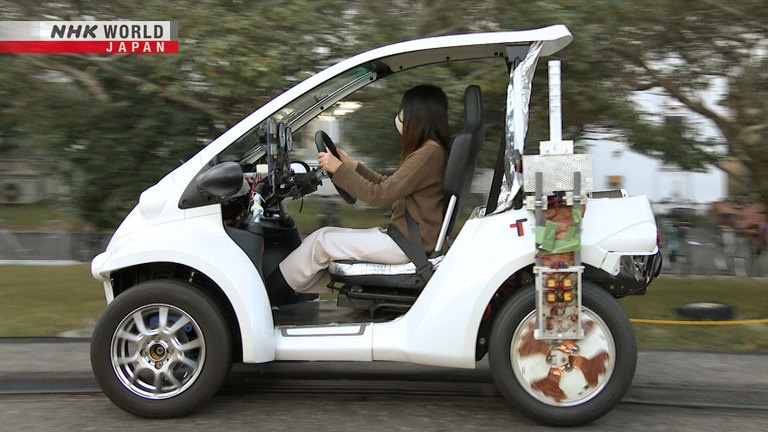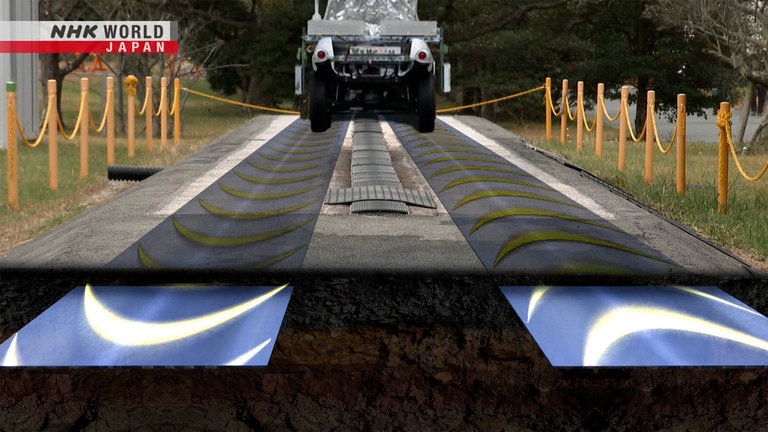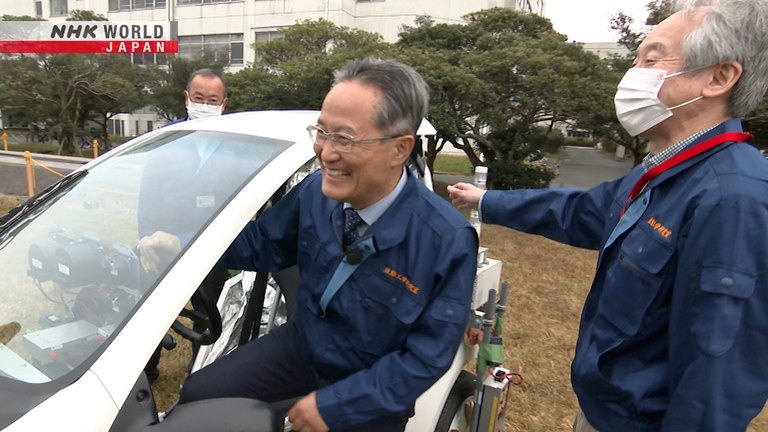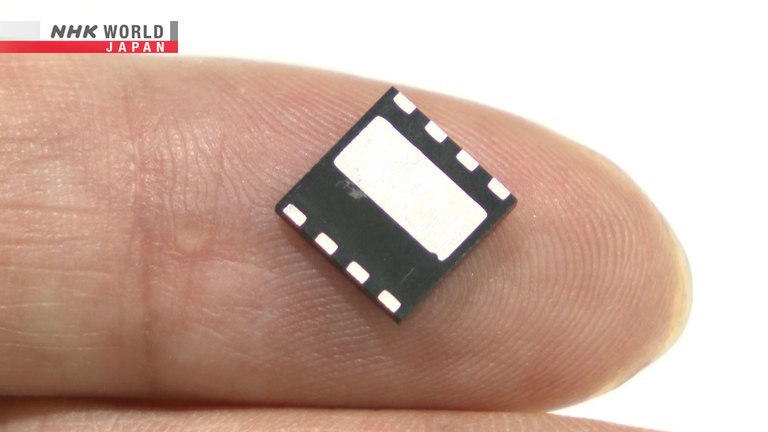Special Episode: Laying the Groundwork for Wireless Power Transfer
Countries around the world are now trying to combat global warming. Shifting from gasoline-powered vehicles to electric vehicles (EVs) is one way to reduce CO2 emissions. Yet adoption of EVs has been slow, partly due to issues with EV batteries. They take a long time to recharge, and most do not offer a cruising range that is comparable to gasoline-powered cars. Professor emeritus Takashi OHIRA of Toyohashi University of Technology is working on the development of a wireless power transfer technology that can run a motor by receiving high-frequency wave energy from the road, even without a battery in the car. In this episode, we will introduce Dr. OHIRA's groundbreaking technology, which he has developed from scratch to power a passenger car.




Transcript
Climate change is something that the entire world is working hard to combat.
One hundred and twenty-five countries have pledged to reduce CO2 emissions, a cause of global warming, and to achieve carbon neutrality by the year 2050.
According to 2020 data, CO2 emissions from automobiles accounted for about 15% of total greenhouse gas emissions in Japan.
Various measures are being recommended to reduce these emissions, including the promotion of EVs.
Governments across the world are working to encourage greater use of EVs and other zero-emission vehicles by 2040, as announced in the COP26 declaration.
Japan is even considering a ban on new sales of gasoline-powered vehicles by around 2035.
However, despite such efforts being made to promote EVs around the world, they have yet to reach a significant level of popularity.
This is partly due to the universal problems EVs face.
One of them is the time required for recharging.
While a gasoline-powered car can be refueled in five minutes, regular charging of an EV can take nearly six hours,
even for a compact car with a low-capacity battery.
Charging infrastructure is also insufficient.
In Japan, it's said that another 100,000 charging stations are needed.
This is why many drivers experience frustration when they have to wait for recharging.
Some people don't leave soon after charging,
and I don't know when they'll return.
There are other people waiting too,
but the order of the line isn't clear.
This makes it hard to start charging.
Cruising range is another major challenge.
Gasoline-powered mass-market cars can run 500 kilometers or more on a full tank, but EVs that can go that distance on a full charge are limited to high-spec models.
The development of technology that could provide a solution to such issues facing EVs is now underway at a Japanese university.
This research team is led by Dr. Takashi Ohira of the Toyohashi University of Technology.
The EV receives energy from the road.
That powers its motor and makes it run.
The batteries of this small EV have all been removed.
And yet, it can still run.
How is this possible?
A special power supply system has been built under the road, and the energy emitted from the system is used to power the motor.
Moreover...
The battery has been removed
from this regular drone.
We'll do an experiment to see if energy received
from the road will make the propellers spin.
At this point, the electricity in the road is not on,
but now, we're going to get the energy flowing.
Ok, please turn on the power.
The propellers have started to turn....
The energy used here is the wave energy that Ohira is studying.
This is an innovation that could drastically change global transportation, and, by extension, the global environment.
In this episode, we'll take a closer look at the revolutionary technology that Ohira is working on.
Toyohashi City, Aichi Prefecture.
This is home to a national university of engineering, Toyohashi University of Technology.
Ohira is professor emeritus at the Future Vehicle City Research Center, one of the university's research facilities.
Ohira is conducting research on using waves to move EVs.
Waves are a phenomenon in which vibrations
travel from one point to another.
Examples of this include waves in the ocean,
or radio waves used in TV and radio.
Waves are created by vibrations and are transmitted to other points at regular intervals or frequencies.
Sound and light are typical examples.
Each has wave characteristics and travels to another point.
Television and radio waves also have various frequencies and are transmitted over great distances.
Wireless technology utilizes these characteristics to transmit signals and information.
Since 2010, Ohira has been working on research to use this wireless technology to run EVs.
He began this research after being approached by a major automobile manufacturer.
They want to popularize electric vehicles (EVs),
but users are not buying them.
The problem lies in the batteries.
They take a long time to charge
and have a short cruising range.
The batteries themselves are expensive.
This is why EVs are not becoming popular.
If EVs could receive energy from infrastructure
while running, like a train, they should become more popular.
This is called in-motion charging,
or dynamic wireless powering, and we were asked if we could develop it.
Until then, Ohira had been researching hardware used in communication satellites and cellular phones to transmit information by radio waves.
The automobile manufacturer saw this technology as the key to in-motion charging, and turned to Ohira for the solution.
Physically, it's a very close phenomenon.
The difference is that what is being sent
is not information but energy.
I thought I could utilize the high-frequency
hardware technology I'd cultivated.
Electric trains typically receive power from overhead wires through pantographs to drive their motors.
However, it is not feasible to install such wires above roads for cars.
But if infrastructure similar to overhead wires could be buried under the road and transmit energy wirelessly, it should be possible to power a car.
That's what Ohira thought.
Technology to transmit energy wirelessly actually has a long history and is already being used today in some familiar applications.
Here is an example.
This is a wireless battery for a smartphone.
It has a coil inside.
The smartphone also contains a similar coil, and when the coils are aligned, energy is transmitted from the battery to the smartphone and charging begins.
When an electric current flows through a coil, a magnetic field is generated.
When another coil comes into close proximity, the field induces an electric current in that coil.
Using the magnetic field as a transmission medium is called "inductive coupling."
This can be utilized with in-motion charging for vehicles.
In some countries, buses are actually operated using this system.
Coils are placed at regular intervals along the road, and electricity is supplied only when a bus with its own coil passes over them.
However, Ohira says there are some problems with this system.
With an inductive coupling system,
many coils must be buried under the road.
That's an issue in terms of cost.
Also, power is transmitted only when the transmitting
and receiving coil axes are perfectly aligned, which requires hardware and electronics
with high peak power.
There are many challenges.
It would be very dangerous to keep current flowing through the coils on the road all the time to try to compensate for those shortcomings.
This is because metal moving in a magnetic field generates heat.
So Ohira turned his attention to a different scheme of contactless power transfer, called "capacitive-coupling."
Here is a demonstration.
A rubber sheet, which is an insulator, is placed on top of plate electrodes connected to the power source, and electrodes connected to a light bulb
are placed on top of the insulator.
The electrodes are not coiled and are disconnected from each other, but when the power is turned on...
The bulb lights up.
How does this happen?
The flow of electricity is the flow of positive and negative charges.
Positive charges flow from positive to negative, while electrons with a negative charge flow in the opposite direction, from negative to positive.
Current flowing means that this phenomenon is occurring.
When an electrical circuit is broken, little or no charge transfer occurs, so no current flows.
However, negative charges attracted to the power supply's positive pole, and positive charges attracted to the power supply's negative pole will collect
on the light bulb's electrodes.
Then, if the positive and negative polarity of the power supply is reversed, this will cause a charge transfer on the light bulb side.
By repeating this reversal, the same phenomenon occurs as when a direct current is applied.
In 2012, Ohira built the world's first model vehicles that run on capacitive-coupling wireless power transfer.
This is the electrified track on which the cars will run.
On the back, two electrodes line both sides of the track.
This car was designed to run on 2 AA batteries.
Yet, we removed both batteries and instead
handmade a wireless power receiving circuit.
The car's metal rear wheels serve as the electrodes.
Now, let's place a car on the track and apply electric voltage to the electrodes on the road.
The car starts running successfully.
The charge in the electrodes underneath the course alternates rapidly, and the current flows to the motor, moving the model car.
The vehicle proved that even without batteries, it can run as long as it receives energy from the road surface.
Based on the data obtained from the model experiment, Ohira began work in 2014 on developing a small EV that a person could actually ride.
However, developing the system was not easy, as it requires approximately 1,000 times more power than the model.
High-frequency circuit design theory
was not developed at all.
There was no circuit design method
or system design method for capacitive-coupling wireless
power transfer (WPT) in any papers,
so we had to start by creating
the theory here at the university.
That was the most difficult part.
The new theory of circuit design quantifies the performance of circuit components and maximizes the performance of electrical systems.
Ohira says he spent almost two years on its establishment.
Then, based on the theory, he built a 30-meter-long test course on campus with stainless steel plates embedded to serve as electrodes.
He repeated the experiment with the goal of completing the course using only wireless power transfer.
And in 2016, he succeeded in the world's first EV driving test that ran solely on wireless power transfer, without using any batteries.
The key to success was the frequency of the electric current.
The higher the number of electrode reversals per second, the higher the frequency, and the higher the current can flow.
Ohira and his team were able to achieve enough power to move the model car by converting the current to the road-side electrodes to a frequency 200,000 times
higher than the current used in homes.
Ohira performed another test run for us on his campus' new test course.
The course is the same as the old course, 30 meters straight.
Under the asphalt are two rows of stainless steel plates that serve as electrodes.
This is a commercially-available small electric car.
We've removed the batteries it came with.
Normally, lead-acid batteries weighing a total of 120 kilograms are installed under the floor.
Here, all of them have been removed.
The energy supplied by batteries will instead be received from the road.
Like the model cars, the electrodes on the vehicle body that will receive this energy utilize metal that was already there.
The steel belts inside the tires.
Tires typically contain steel belts to maintain their mechanical strength.
The steel belt is used as an electrode to conduct electric current to the motor.
We can make good use of the tires as they are.
And now the test gets underway.
The transmitted power is gradually increased, and when it reaches a predetermined level, it is ready to start.
The course is short, so the car cannot go too fast, but theoretically, it can reach 60 kilometers per hour.
The approximately 300-kilogram vehicle was able to move 30 meters just by waves.
This system picks up wave energy flowing through electrodes while running and supplies power.
It also excels in safety and operability.
When there are no cars on the road, the electric flux only lies horizontally between the electrodes underground, so there is very small leakage onto the road.
When a car with electrodes approaches, the electrical flux is automatically directed to the nearest electrode, so there is no need to control the output every time a car comes along.
And if the EV does have a battery, it can be recharged with excess power.
However, the system is not yet perfect, of course.
The biggest challenge is how to efficiently convert large amounts of electricity into high-frequency power that can be used to power even large vehicles.
If the efficiency is low, more heat is generated,
so it'll need something like water cooling.
If we can increase efficiency, we can build an air-
cooled system instead of a water-cooled system.
With air-cooling, the system
can be smaller and lighter.
The more power you try to generate, the more heat the inverter will generate.
If the conversion efficiency is poor, its temperature will be even higher.
To avoid this, a more efficient conversion system is required.
The key to overcoming this issue lies in this small part, less than a centimeter long.
This is a semiconductor called gallium nitride.
Compared to conventional semiconductors,
it generates high-frequency energy more efficiently.
It also generates less heat.
This is one of what are generally called power semiconductors.
They can withstand high voltages, and because electrons move easily, the circuits themselves can run at high speeds.
If a circuit that successfully incorporates these semiconductors can be perfected, a high-power wireless power transfer system that generates less heat
and more safely produces high-frequency energy could be realized.
Ohira is continuing his research, aiming to complete the system within three years.
Ohira is leading research on wireless power transfer technology.
The origin of his research path lies in an unexpected place...
his pastime of visiting hot springs.
His parents often took him to hot springs when he was a child, and he still makes a point of visiting one every month.
He credits hot springs with sparking his interest in wave action.
When I was in elementary school, I noticed this hot water pouring in,
and traveling across the surface.
I wondered what rules created
such beautiful patterns.
I thought that if this were expressed with math,
it would be very beautiful.
Hot springs equal waves.
After studying communication engineering at university, Ohira went on to work for one of the largest telecommunications companies in Japan, designing communications satellites.
He then worked at a research institute in the field of telecommunications before moving to his current university.
The theory is interesting.
All waves behave under a unified equation.
That's the nature of it.
It's a fascinating theory.
Moreover, when a car is actually moving
or a light bulb is shining brightly, that's something you can see with your own eyes and
feel with your five senses.
That's the second interesting thing about waves.
Ohira's research has now begun to take a new turn.
With the cooperation of Yamanashi Prefecture's city of Fujiyoshida, located at the base of Mt. Fuji, and a local company,
he decided to build a circular track for a demonstration test of in-motion charging.
This project entails clearing a 65,000-square-meter forest at the foot of Mt. Fuji and creating a circular test course of about 800 meters in length.
He is now proceeding with the design and holding detailed meetings with staff from the partner company to prepare for the start of construction.
To emphasize the importance of this experiment
for social implementation, we requested that the test course
be as large as possible,
with straightaways as well to test speed.
Dr. Ohira is flexible in his thinking, and I can sense his passion
to make this research even better.
The new test course is expected to be completed within three years.
Since it's a circular track, it will allow collection of data on how much charge an on-board battery can hold in relation to the distance traveled.
Normal EVs lose battery power the longer they run, but on this electrified road,
we should achieve an ideal situation
where battery power increases
the longer the vehicle is driven.
This is what we'll test.
After all the issues have been cleared in the experiments on this circular track, Ohira has his sights set on electrification of the expressway.
As a first step, he's thinking of electrifying one lane.
Then that lane can be used as a charging spot for EVs.
After that, the number of electrified lanes could gradually be increased.
This would be a paradigm shift.
If all gasoline-powered vehicles in Japan were replaced by EVs, it is believed that one-tenth of current total annual CO2 emissions could be eliminated.
Ohira believes that, from a technological standpoint, this could be possible within five years.
In addition to the construction of the circular track, another major project is underway.
The Fuji Tozan Railway concept planned by Yamanashi Prefecture.
This railroad is intended to replace the current toll road from the foot of Mt. Fuji to the fifth station with a tram in order to relieve traffic and congestion
caused by the increase in tourists.
It is hoped that Ohira's wireless power transfer technology can be applied here too.
Even more power is needed for a mountain railroad as it requires vertical energy due to the difference
in elevation, in addition to horizontal movement.
We're now developing 10kW technology,
and trying to synthesize power with multiple units.
For example, if 100 units are combined,
100 times more power can be obtained.
That's the technological challenge going forward.
If achieved, this will become the world's first wireless powered tram in a mountainous area.
Ohira has focused on wireless power transfer technology based on capacitive coupling, which has greatly expanded in potential through his research.
Ohira envisions this network expanding from his university to Japan, and then on to the world.
With capacitive-coupling WPT, EVs will
become a mainstream means of transportation.
This will reduce the environmental burden,
and significantly contribute to carbon neutrality.
A small wave that started in a Japan university may soon transform into a large wave that dramatically changes the global environment.